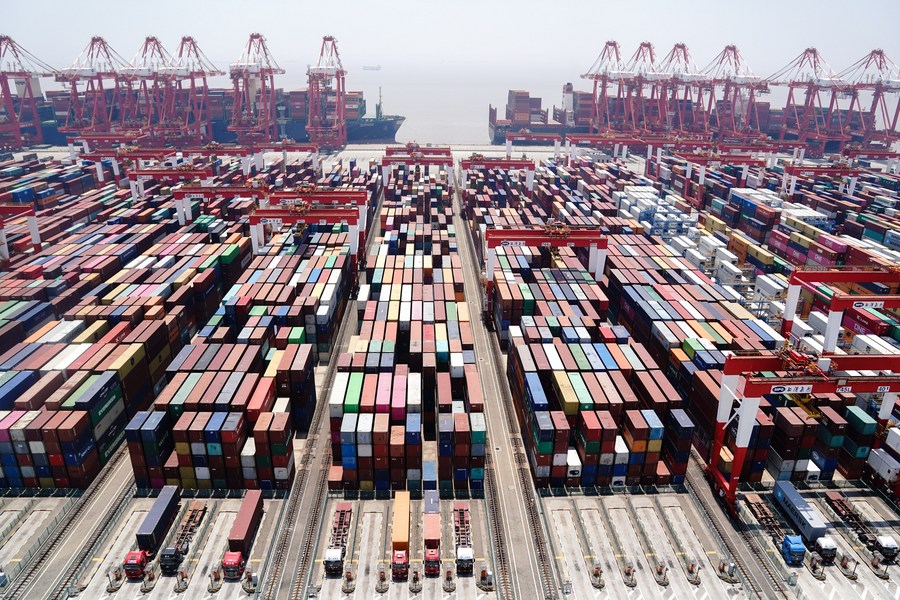China makes significant progress in building framework for world-leading waterway networks
China has accelerated the construction of its waterway infrastructure since 2012 and has made remarkable progress in the building of a framework for waterway networks.
The county has continuously improved its high-grade waterway networks. By the end of 2021, China had 128,000 kilometers of navigable inland waterways, the longest in the world, including over 16,000 kilometers of high-grade inland waterways.

Photo taken on May 17, 2022 shows a view of the automated container terminal of Shanghai Yangshan Deep Water Port in east China's Shanghai. (Xinhua/Ding Ting)
Through many years of construction, China has basically completed the building of the framework for waterway networks linking rivers and seas, trunk lines and branch lines, according to Su Jie, deputy director-general of the Comprehensive Planning Department of the country’s Ministry of Transport (MOT).
The trunk line of the Yangtze River has become the world’s busiest water channel, achieving the largest transportation capacity for 10 consecutive years in a row. A total of 3.53 billion tonnes of cargo were shipped through the trunk line of the river in 2021, according to data from the administration of navigational affairs on the Yangtze River under the MOT.
China has sped up the construction of large and specialized berths. The country has meanwhile mastered key technologies for the construction and operation of automated container terminals. The numbers of automated container terminals China has built and that are currently under construction both rank first in the world.
As of the end of 2021, China had 20,867 berths in operation, including 2,659 berths capable of handling 10,000-tonne ships or even larger, up 41 percent from 2012, according to Liu Peng, deputy head of the Water Transport Bureau under the MOT. Eight and seven of the world’s largest ports in terms of cargo throughput and container throughput are in China. The country has basically completed the formation of several world-class port clusters. These include the clusters around the Yangtze River Delta, the Tianjin-Hebei region, and the Guangdong-Hong Kong-Macao Greater Bay Area.
China has become a powerhouse in the area of water transportation and has gained much international influence in this respect, which has provided support for the country’s high-quality socio-economic development.
In 2021, China’s waterway cargo transport volume reached 8.24 billion tonnes, ranking first in the world. In terms of waterway transport, the waterway freight turnover volume hit 11.6 trillion tonne-kilometers.
In 2021, Chinese ports handled about 15.55 billion tonnes of cargo and 283 million twenty-foot equivalent unit containers, outnumbering those by any other country in the world.
Besides, China has international waterway transport routes that are the best connected to the global shipping network.
China is expected to have 25,000 kilometers of high-grade waterways, with 27 major coastal ports and 36 major inland ports by 2035, according to a comprehensive transport blueprint unveiled by the country in 2021.
China will keep shoring up the weak spots in its waterway networks and accelerating the high-quality development of its overall waterway infrastructure, Su said. The country will take multiple measures to make high-grade waterways operate more smoothly and give better play to the role of coastal ports.
China will accelerate the establishment of a combined, standardized and information-based sea-rail transportation system, and advance the construction of specialized berths for grain, energy resources, ores and transport containers, among other categories. The country will also encourage its 11 international hub ports to further expand their global routes and logistics networks.
Photos
Related Stories
- Shanghai Port registers record throughput in July
- Coordinated development energizes Chinese port city
- World's first multimodal service port opens in Guangdong
- China's Caofeidian Port sees rise in cargo throughput
- China's first sea-rail automated container terminal put into operation
- China's major ports see steady growth in container throughput in May
- China's ports see higher throughput in May
- Cargo throughput rises significantly at Shanghai airport
- Shanghai Port sees container throughput recover
- East China port sees record high monthly container throughput
- Waterway being built on cliffs along the Jinsha River
- New law aims to save nation’s waterways from disappearing
- Public opinion sought on waterway draft law
- Low water level detains over 700 boats in E China waterway
- China vows to strengthen inland waterway transport
Copyright © 2022 People's Daily Online. All Rights Reserved.









